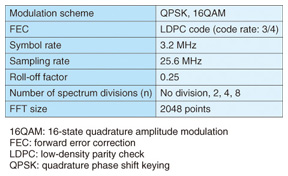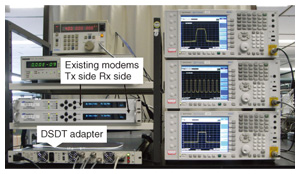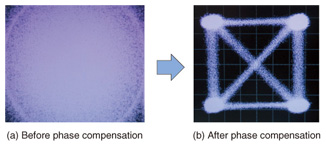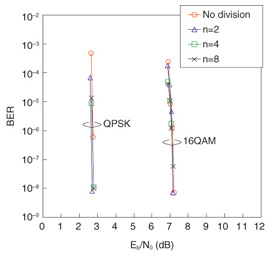 |
|||||||||||
|
|
|||||||||||
|
Feature Articles: Latest Development Trend at NTT Access Network Service Systems Laboratories Vol. 10, No. 6, pp. 15–20, June 2012. https://doi.org/10.53829/ntr201206fa3 Direct Spectrum Division Transmission for High-capacity Satellite CommunicationsAbstractWe investigated direct spectrum division transmission (DSDT) for satellite communications. A DSDT-based satellite communication system can be made by modifying the design of the existing satellite communication system by inserting a DSDT adapter between the modem and antenna. On the transmitter side, the DSDT adapter divides the modem's output signal into multiple sub-spectra and assigns them to unused frequency resources. On the receiver side, the divided sub-spectra are combined and the original signal is regenerated. Therefore, the DSDT system utilizes existing satellite communication system components and achieves higher frequency utilization efficiency. Experiments on a prototype DSDT adapter show that its resulting bit error rate performance is close to that in the case without spectrum division. The results demonstrate that the DSDT adapter achieves flexible spectrum division and hence enables high-capacity satellite communications.
1. IntroductionMuch of eastern Japan was severely impacted by the Great East Japan Earthquake on March 11, 2011. Many cities were destroyed by tsunami, liquefaction, and subsidence. Since terrestrial communication systems were also seriously damaged, satellite communications became essential in afflicted areas. Before the disaster, satellite communications was being used to provide telephone and fax services, but after the disaster, Internet connectivity was the dominant demand [1]. However, since frequency resources are limited, Internet connection services must share the bandwidth with existing telephone and fax services. In typical satellite communication systems, demand assigned multiple access (DAMA) provides the frequency resources of the satellite transponder to user earth stations (UESs). Since each UES releases its assigned frequency resources after disconnection, the transponder’s unused frequency resources, which may not be wide enough to be reallocated to new users, become scattered. This fragmentation of the frequency resources seriously degrades frequency utilization efficiency. Moreover, existing satellite communication devices need to be used efficiently because of their long life cycle. This article introduces the concept of direct spectrum division transmission (DSDT) for satellite communications [2], [3]. A DSDT-based satellite communication system can be made by modifying the design of the existing satellite communication system by inserting a DSDT adapter between the modem and antenna. On the transmitter (Tx) side, the DSDT adapter divides the output signal of the existing modem into multiple sub-spectra in the frequency domain and assigns them to unused frequency resources according to the frequency usage load on the satellite transponder. Therefore, the DSDT system has higher frequency utilization efficiency than the existing system. On the receiver (Rx) side, divided sub-spectra are combined and the original signal is regenerated in the DSDT adapter. The regenerated signal is demodulated by the existing Rx modem. This article explains the concept and principle of DSDT and describes an experimental evaluation of the performance of a prototype DSDT adapter. 2. Key issueThe conventional DAMA-based satellite communication system is shown in Fig. 1. User terminals, such as telephones, faxes, smartphones, and personal computers, are connected to the UESs. Telephone and Internet connections are provided via the satellite transponder and the base station. For the duration of its communication session, each user is assigned a transmission channel with a different frequency, and the modem of the UES outputs a signal with a single carrier frequency modulated by the data to be transmitted. Consider the case in which UES5 requests a contiguous wide frequency band for broadband communications. Since the unused resources are fragmented, no frequency resource can be assigned to UES5 even though the total available capacity is sufficient to meet the demand. To have higher efficiency, each UES must be able to use fragmented frequency resources in the most flexible manner possible.
3. System conceptThe concept of the DSDT system is shown in Fig. 2. On the Tx side, the DSDT adapter converts the output signal of the existing modem into a frequency-domain signal by applying a fast Fourier transform (FFT) and divides it into multiple sub-spectra by using a spectrum dividing filter bank (Fig. 3(a)). The satellite assigns the divided sub-spectra to unused frequency resources and converts them into a single time-domain signal by applying an inverse FFT (IFFT). On the Rx side, the DSDT adapter converts the received sub-spectra into the frequency domain by an FFT and re-shifts and combines all the sub-spectra by using its spectrum combining filter bank (Fig. 3(b)). It converts the combined signal into the time domain by an IFFT. The output signal of the DSDT adapter is demodulated by the existing modem.
4. Technical problem and novel approachIn the DSDT system, since received sub-spectra undergo independent phase offsets owing to the propagation delay, each Rx sub-spectrum undergoes phase distortion, as shown in Fig. 4(a). In the Rx filter bank, sub-spectra k (k=1, 2, …, n, n: number of spectrum divisions), which are shifted by fsk on the Tx side, are re-shifted by -fsk to regenerate the original signal. This frequency shift makes the phase characteristics of the regenerated signal become discontinuous, which invalidates the distortionless condition; consequently, the bit error rate (BER) performance is degraded, as shown in Fig. 4(b).
In addition, the DSDT system does not know the frame format of the existing modem because of its adapter-based design. Therefore, the phase distortion cannot be compensated for by using a specific frame pattern. For phase distortion compensation, we use a blind phase compensation method (Fig. 5). Since the Rx-filtered and re-shifted sub-spectra undergo a phase shift due to the propagation delay, adjacent sub-spectra exhibit significant phase difference φk, as shown in Fig. 5(c). This compensation method estimates and compensates for φk for each pair of sub-spectra independently [4].
Since the blind phase compensation method estimates the phase compensation values regardless of the modulated signal spectrum patterns, no pilot signal or specific frame format is required. 5. Experimental evaluationThe performance of the DSDT system was evaluated in several experiments using a prototype DSDT adapter. As the existing satellite modem, we used Comtech EF Data CDM-625. The experimental parameters are shown in Table 1 and the experimental configuration is shown in Fig. 6.
The output signal of the existing modem is shown in Fig. 7(a). The DSDT adapter divided the signal into multiple sub-spectra, as shown in Fig. 7(b). Received sub-spectra were combined and the original signal was regenerated by the combining filter bank, as shown in Fig. 7(c). These observations confirm that the modulated signal was regenerated.
The quadrature phase shift keying (QPSK) constellations before and after phase compensation by the blind phase compensation method are shown in Fig. 8. The phase shift compensation was satisfactory. The BER performance is shown in Fig. 9, where the BER is plotted against the ratio of the energy per bit to noise power spectral density (Eb/N0). For both of the modulation schemes tested, QPSK and 16-state quadrature amplitude modulation, the degradation in carrier-to-noise ratio was negligible compared with the undivided case.
These results demonstrate that the DSDT system can compensate for phase distortion satisfactorily and achieve flexible spectrum division. 6. ConclusionThis article described direct spectrum division transmission (DSDT) for satellite communications and an experimental evaluation of the DSDT system. Experiments on a prototype showed that the system’s BER performance was close to that in the undivided case. Thus, we conclude that the DSDT system can divide the output signal of an existing modem flexibly and achieve high-capacity satellite communications. AcknowledgmentsThis work is related to research sponsored by the Ministry of Internal Affairs and Communications through grants for “Research and Development on Dynamic Polarization and Frequency Control Technologies for High-capacity Satellite Communications”. References
|
|||||||||||






















